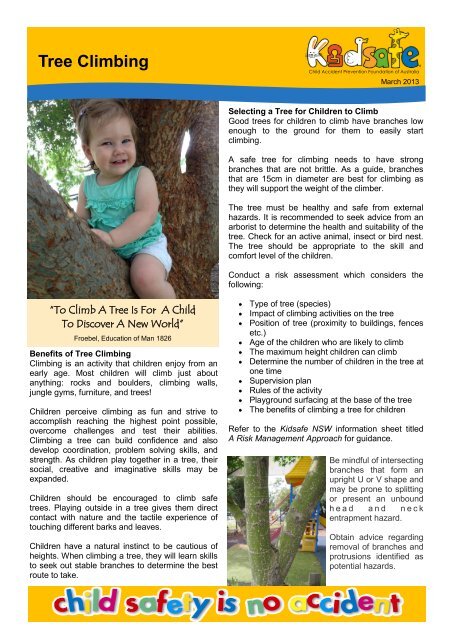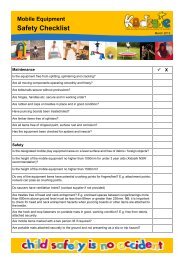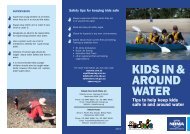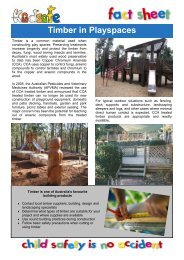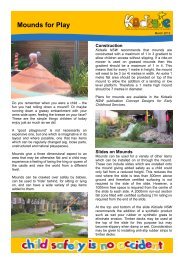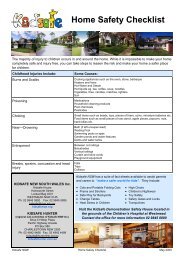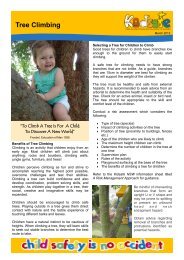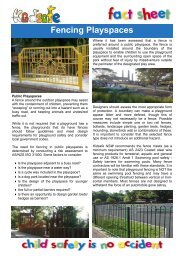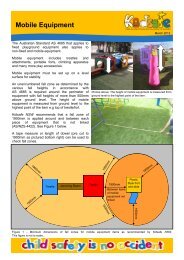Tree Climbing - Kidsafe NSW
Tree Climbing - Kidsafe NSW
Tree Climbing - Kidsafe NSW
Create successful ePaper yourself
Turn your PDF publications into a flip-book with our unique Google optimized e-Paper software.
<strong>Tree</strong> <strong>Climbing</strong><br />
Child Accident Prevention Foundation of Australia<br />
March 2013<br />
Selecting a <strong>Tree</strong> for Children to Climb<br />
Good trees for children to climb have branches low<br />
enough to the ground for them to easily start<br />
climbing.<br />
A safe tree for climbing needs to have strong<br />
branches that are not brittle. As a guide, branches<br />
that are 15cm in diameter are best for climbing as<br />
they will support the weight of the climber.<br />
The tree must be healthy and safe from external<br />
hazards. It is recommended to seek advice from an<br />
arborist to determine the health and suitability of the<br />
tree. Check for an active animal, insect or bird nest.<br />
The tree should be appropriate to the skill and<br />
comfort level of the children.<br />
Conduct a risk assessment which considers the<br />
following:<br />
“To Climb A <strong>Tree</strong> Is For A Child<br />
To Discover A New World”<br />
Froebel, Education of Man 1826<br />
Benefits of <strong>Tree</strong> <strong>Climbing</strong><br />
<strong>Climbing</strong> is an activity that children enjoy from an<br />
early age. Most children will climb just about<br />
anything: rocks and boulders, climbing walls,<br />
jungle gyms, furniture, and trees!<br />
Children perceive climbing as fun and strive to<br />
accomplish reaching the highest point possible,<br />
overcome challenges and test their abilities.<br />
<strong>Climbing</strong> a tree can build confidence and also<br />
develop coordination, problem solving skills, and<br />
strength. As children play together in a tree, their<br />
social, creative and imaginative skills may be<br />
expanded.<br />
Children should be encouraged to climb safe<br />
trees. Playing outside in a tree gives them direct<br />
contact with nature and the tactile experience of<br />
touching different barks and leaves.<br />
Children have a natural instinct to be cautious of<br />
heights. When climbing a tree, they will learn skills<br />
to seek out stable branches to determine the best<br />
route to take.<br />
Type of tree (species)<br />
Impact of climbing activities on the tree<br />
Position of tree (proximity to buildings, fences<br />
etc.)<br />
Age of the children who are likely to climb<br />
The maximum height children can climb<br />
Determine the number of children in the tree at<br />
one time<br />
Supervision plan<br />
Rules of the activity<br />
Playground surfacing at the base of the tree<br />
The benefits of climbing a tree for children<br />
Refer to the <strong>Kidsafe</strong> <strong>NSW</strong> information sheet titled<br />
A Risk Management Approach for guidance.<br />
Be mindful of intersecting<br />
branches that form an<br />
upright U or V shape and<br />
may be prone to splitting<br />
or present an unbound<br />
h e a d a n d n e c k<br />
entrapment hazard.<br />
Obtain advice regarding<br />
removal of branches and<br />
protrusions identified as<br />
potential hazards.
Preparing the <strong>Tree</strong> for <strong>Climbing</strong> Activity<br />
Inspect the tree before climbing<br />
Always conduct a thorough inspection of the<br />
tree for its health and for potential hazards<br />
before each climbing session. A tree that<br />
shows signs of wear or weakness is not<br />
suitable for climbing.<br />
Remove obstacles<br />
Ensure that debris, toys and other potentially<br />
hazardous items are removed from around the<br />
base of the tree. Children need to be able to<br />
independently access the tree without<br />
assistance from ladders, steps or stairs.<br />
Always be alert<br />
Unforeseen circumstances, such as a sudden<br />
gust of wind, breaking tree limb or an attack<br />
from a protective wildlife parent, make it<br />
imperative that you always be alert to danger.<br />
Always ensure a supervising adult is present<br />
when tree climbing.<br />
Mark the limits<br />
Highlight to children the maximum climbing<br />
height by painting a mark on the tree branches.<br />
It is recommended to limit the maximum fall<br />
height to 1000mm above ground level.<br />
Soft Surfacing<br />
Provide a soft surfacing surrounding the tree.<br />
Surfacing types include well maintained grass,<br />
mulch/sand (maintained at a minimum depth of<br />
150mm), vinyl covered foam mats.<br />
Explain the Rules<br />
Children need to know the rules for climbing on<br />
the tree. These may include:<br />
The maximum number of children in the tree<br />
at a time.<br />
The maximum height children can climb.<br />
Whether children can hang or swing from a<br />
branch.<br />
The twigs and branches need to stay on the<br />
tree. Respect the tree.<br />
Shoes are worn.<br />
3 points of contact at all times.<br />
That children can climb down by themselves.<br />
That children are expected to watch out for<br />
others.<br />
KIDSAFE NEW SOUTH WALES Inc.<br />
<strong>Kidsafe</strong> <strong>NSW</strong> Playground Advisory Unit<br />
P: 02 9845 0893 F: 02 9845 0895<br />
E: kidsafe@chw.edu.au<br />
kidsafensw.org<br />
Child Accident Prevention Foundation of Australia


